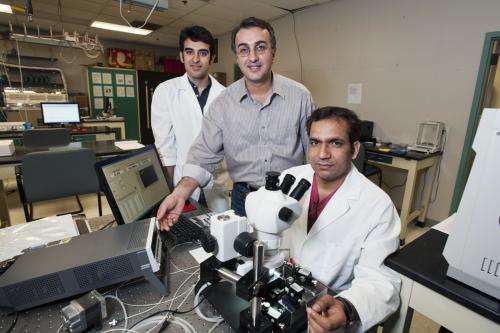Researchers fine-tune the sensitivity of nano-chemical sensor

Researchers have discovered a technique for controlling the sensitivity of graphene chemical sensors.
The sensors, made of an insulating base coated with a graphene sheet—a single-atom-thick layer of carbon—are already so sensitive that they can detect an individual molecule of gas. But manipulating the chemical properties of the insulating layer, without altering the graphene layer, may yet improve their ability to detect the most minute concentrations of various gases.
The finding "will open up entirely new possibilities for modulation and control of the chemical sensitivity of these sensors, without compromising the intrinsic electrical and structural properties of graphene," says Amin Salehi-Khojin, assistant professor of mechanical and industrial engineering at the University of Illinois at Chicago, and principal investigator on the study. He and his coworkers at the UIC College of Engineering collaborated with researchers from the Beckman Institute and the Micro and Nanotechnology Laboratory at the University of Illinois at Urbana-Champaign and two institutions in Korea. Their findings are reported in the journal Nano Letter, available online in advance of publication.
Since its discovery nearly 10 years ago, graphene—in sheets, or rolled into nanotubes—has attracted huge scientific interest. Composed of a single layer of carbon atoms, graphene has potential for use in hundreds of high-tech applications. Its 2-D structure, exposing its entire volume, makes it attractive as a highly sensitive gas detector.
Salehi-Khojin's team, and others, earlier found that graphene chemical sensors depended on a structural flaw around a carbon atom for their sensitivity. They set out to show that "pristine" graphene sensors—made of graphene that was perfectly flawless—wouldn't work. But when they tested these sensors, they found they were still sensitive to trace gas molecules.
"This was a very surprising result," Salehi-Khojin said.
The researchers tested the sensor layer by layer. They found that pristine graphene is insensitive, as they had predicted.
They next set about removing any flaws, or reactive sites called dangling bonds, from the insulating layer. When a pristine insulating layer was tested with pristine graphene, again there was no sensitivity.
"But when dangling bonds were added back onto the insulating layer, we observed a response," said Bijandra Kumar, a post-doctoral research associate at UIC and first author of the Nano Letter study.
"We could now say that graphene itself is insensitive unless it has defects—internal defects on the graphene surface, or external defects on the substrate surface," said UIC graduate student Poya Yasaei.
The finding opens up a new "design space," Salehi-Khojin said. Controlling external defects in the supporting substrates will allow graphene chemFETs to be engineered that may be useful in a wide variety of applications.
Provided by University of Illinois at Chicago



















